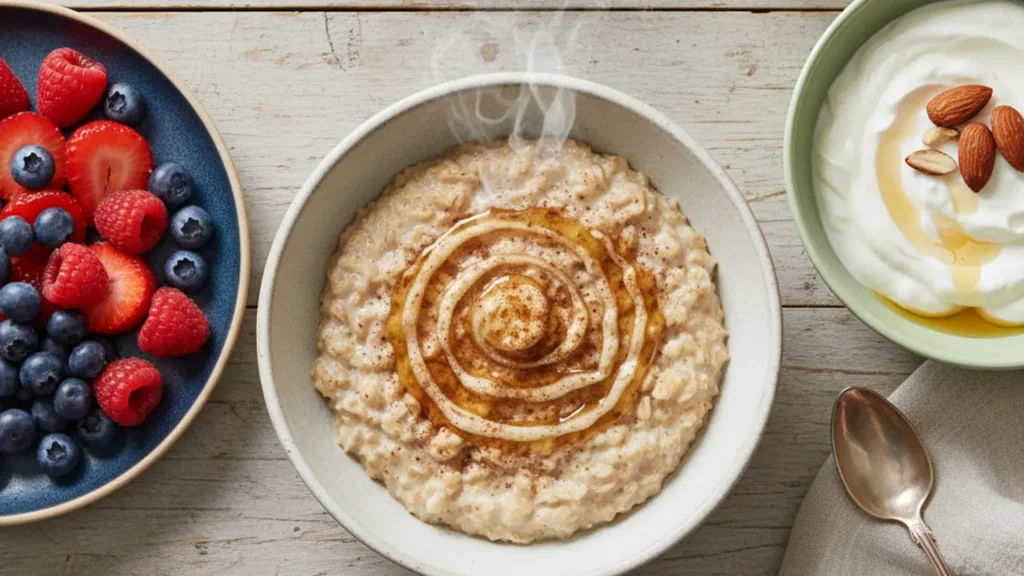Healthy eating is important at every age, but for seniors, it carries more weight. The body changes with time. Energy needs go down, but the need for good nutrients goes up. This means every meal matters more.
Skipping planning can lead to meals that lack protein, fiber, or vitamins. That can affect strength, energy, and memory. It can also raise risks for illness. With simple planning, meals can support health and make daily life easier.
In this article, you will find clear meal ideas and strategies. You will also discover tricks to make meal planning less stressful. By the end, you will have a simple roadmap to follow.
Building Balanced Meals Without Stress
Balanced meals are not about rules or strict diets. They are about covering three main parts: protein, fiber, and healthy fats. Seniors need protein to keep muscles strong. Fiber helps with digestion and keeps blood sugar steady. Healthy fats support the brain and joints.
A simple plate can cover all three. Chicken with rice and broccoli. Salmon with sweet potato and green beans. Eggs with whole grain toast and fruit. Each of these meals is easy, filling, and full of the nutrients seniors need.
Adding variety is also key. Try mixing in beans, lentils, or tofu for plant-based protein. Use brown rice, oats, or quinoa for steady energy. Rotate different fruits and vegetables for vitamins and minerals.
Planning balanced meals also cuts down waste. When you know what you will eat, you buy only what you need. That saves money and makes grocery trips less stressful.
Smart Strategies for Meal Planning
Meal planning does not need to feel complicated. The key is to start small. Begin with just three days of meals instead of a full week. Write down breakfast, lunch, and dinner for those three days. This shorter plan feels easier to manage and gives you a quick win. Once it feels natural, you can move up to planning a full week at a time.
Batch cooking is another powerful strategy. Preparing extra food in one cooking session saves both time and energy. For example, cook a pot of soup and divide it into smaller containers.
Roast a tray of chicken breasts and pair them with rice or vegetables across several meals. Store portions in the fridge or freezer so you can grab them when you feel tired or don’t want to cook. Having food ready can prevent skipping meals or choosing less healthy options.
A personal “go-to meal list” is a secret weapon. These are quick meals that you enjoy, know how to cook, and always turn out well. For instance, a tuna sandwich with sliced vegetables, a vegetable omelet with whole grain toast, or a chicken stir-fry with frozen vegetables.
Keep your list written down on paper or on your fridge. On days when planning feels overwhelming, this list will help you put together meals without stress.
Stocking a pantry with healthy basics makes planning much smoother. Keep canned beans, canned tuna, oats, peanut butter, frozen vegetables, and whole grain pasta on hand.
With these, you can put together simple meals in minutes. For example, beans with rice and vegetables, pasta with tomato sauce and tuna, or oatmeal with peanut butter and fruit. Having these foods available means you always have backup options.
Portion control is another smart move. Eating too much food can make you feel heavy and sluggish. Eating too little can leave you weak and tired. Aim for balanced portions: half the plate filled with vegetables, one-quarter with protein, and one-quarter with a grain or starch. This simple visual guide works well without needing to measure or count calories.
You can also use tools to make meal planning easier. A small notebook, a calendar, or a weekly chart on your fridge can help track meals. Writing things down makes it clear what you need to buy and reduces last-minute decisions. Some seniors also find it useful to shop with a grocery list that matches their meal plan. This helps avoid unnecessary items and keeps costs down.
Flexibility is important too. A plan is not a rulebook—it’s a guide. If you don’t feel like eating what you planned for dinner, switch it with tomorrow’s meal. If a new ingredient catches your eye at the store, swap it in. The goal is to make eating easier and healthier, not rigid or stressful.
Finally, remember to plan snacks and hydration. Healthy snacks such as nuts, fruit, yogurt, or boiled eggs can keep your energy steady between meals. Planning drinks is just as important. Water, herbal tea, and soups help you stay hydrated throughout the day.
When you combine small steps, batch cooking, a go-to meal list, pantry basics, portion control, and flexibility, meal planning turns from a chore into a helpful routine. These strategies build confidence and reduce stress, making every meal a chance to support health and energy.
Easy Meal Ideas for Seniors
Here are simple meal ideas that follow the balanced plate rule.
Breakfast:
- Oatmeal with berries and yogurt
- Scrambled eggs with spinach and whole grain toast
- Peanut butter on toast with a banana
- Greek yogurt with walnuts and sliced apples
Lunch:
- Tuna sandwich on whole grain bread with cucumbers and carrots
- Lentil soup with a small side salad
- Chicken salad with olive oil dressing and whole grain crackers
- Turkey wrap with lettuce, tomato, and avocado
Dinner:
- Grilled salmon with sweet potato and steamed broccoli
- Baked chicken with brown rice and green beans
- Vegetable stir-fry with tofu and quinoa
- Turkey meatballs with whole wheat pasta and spinach
Snacks:
- A handful of almonds
- Hummus with carrot sticks
- Cottage cheese with pineapple
- A boiled egg with cherry tomatoes
These meals are simple, quick, and full of the nutrients seniors need. They can also be adjusted for taste and preference.
Adding herbs and spices makes meals tasty without heavy salt. Fresh parsley, garlic, turmeric, and oregano bring flavor and also carry health benefits.
Hydration is just as important as meals. Seniors need water through the day to prevent fatigue and confusion. Herbal teas and soups also count toward fluid intake.
Making Meal Planning a Daily Habit
Meal planning works best when it becomes routine. Start by picking one day to plan for the week. Write down what you will eat and make a shopping list. Stick the plan on the fridge for easy access.
Cooking does not need to take much time. Aim for meals that can be prepared in 20 to 30 minutes. Use shortcuts such as frozen vegetables, pre-washed greens, and canned beans. These save time and still give the same nutrition.
Eating with others can also make meals more enjoyable. Sharing food with family or friends brings both nutrition and connection. When eating alone, setting the table nicely and focusing on the meal can make it feel more satisfying.
Do not be afraid to adjust your plan. Some days you may not feel hungry for a large dinner. A bowl of soup and bread can be enough. Other days, you may want more protein. Planning should be flexible, not rigid.
Over time, meal planning turns into a habit. You will notice that grocery shopping is faster, cooking feels easier, and your meals support your health better. The payoff is steady energy, strength, and peace of mind.
Meal planning does not need to be hard or stressful. For seniors, it can be the key to better health, stronger energy, and daily comfort. A simple plan with balanced meals makes eating easier and more enjoyable.
The path starts with small steps. Plan three days of meals. Keep a list of easy meal ideas. Use smart strategies such as batch cooking and pantry staples. Slowly, this becomes a daily habit.
The payoff is clear. Stronger muscles. Better digestion. More energy to enjoy each day. And less worry about what to eat.
Meal planning is not about rules. It is about making life easier, healthier, and more enjoyable. Start today, and let food work for your health every single day.




